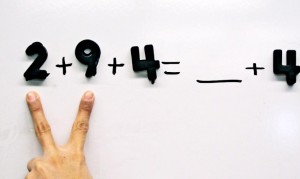
Children gain a deeper understanding of math and perform better when doing a problem if they use hand gestures, new research shows.
Previous research has found that gestures can help children learn. The new study, published online in Psychological Science, was designed to address the questions of whether abstract gesture can support generalization beyond a particular problem and if abstract gesture is a more effective teaching tool than concrete action.
“We found that acting gave children a relatively shallow understanding of a novel math concept, whereas gesturing led to deeper and more flexible learning,” says the study’s lead author, Miriam A. Novack, a doctoral student in the University of Chicago’s department of psychology’s developmental program.
The researchers taught third-grade children a strategy for solving one type of mathematical equivalence problem—for example, 4 + 2 + 6 = ____ + 6. They then tested the students on similar mathematical equivalence problems to determine how well they understood the underlying principle.
The researchers randomly assigned 90 children to conditions in which they learned using different kinds of physical interaction with the material.
In one group, children picked up magnetic number tiles and put them in the proper place in the formula. For example, for the problem 4 + 2 + 6 = ___ + 6, they picked up the 4 and 2 and placed them on a magnetic white board. Another group mimed that action without actually touching the tiles and a third group was taught to use abstract gestures with their hands to solve the equations.
ABSTRACT GESTURES
In the abstract gesture group, children were taught to produce a V-point gesture with their fingers under two of the numbers, metaphorically grouping them, followed by pointing a finger at the blank in the equation.
The children were tested before and after solving each problem in the lesson, including problems that required children to generalize beyond what they had learned in grouping the numbers. For example, they were given problems that were similar to the original one, but had different numbers on both sides of the equation.
Children in all three groups learned the problems they had been taught during the lesson. But only children who gestured during the lesson were successful on the generalization problems.
“Abstract gesture was most effective in encouraging learners to generalize the knowledge they had gained during instruction, action least effective, and concrete gesture somewhere in between,” says senior author Susan Goldin-Meadow, professor of psychology.
“Our findings provide the first evidence that gesture not only supports learning a task at hand but, more importantly, leads to generalization beyond the task. Children appear to learn underlying principles from their actions only insofar as those actions can be interpreted symbolically.”
Source: University of Chicago




